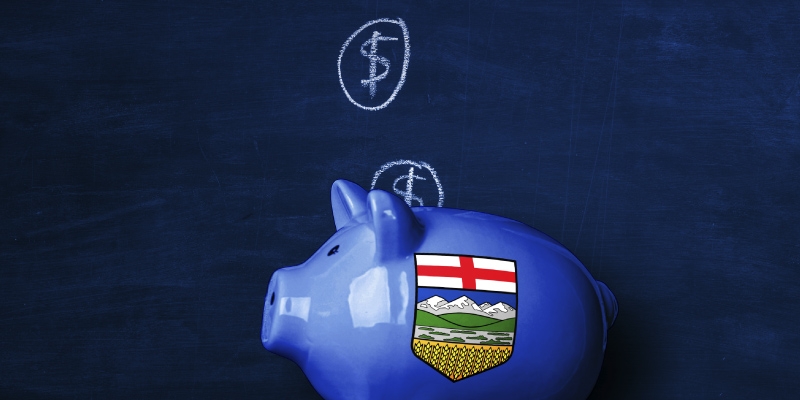Don’t Spend Away the Windfall: Better Options for Alberta’s Unexpected Revenues

Due largely to a record high windfall in resource revenue—worth an expected $28.1 billion in 2022/23—Alberta is projected to run a $12.3 billion budget surplus in 2022/23 with additional surpluses anticipated over the next two fiscal years. History has shown that spending these surpluses only leads the province back into deficits when resource revenues inevitably decline, which sets the province up for hard times down the road. Instead of wasting this extraordinary opportunity by spending away the temporary surpluses, the provincial government could use them to improve Alberta’s finances and economy for the long-term. This essay series presents three such options, all of which are preferable to spending away the windfall.
University of Calgary economist Trevor Tombe suggests the provincial government consider using the surpluses to eliminate the province’s debt. Professor Tombe argues that debt elimination is an attractive option as for the first time in well over a decade government borrowing rates are projected to exceed the expected return on investment savings. In other words, the cost of provincial debt (estimated by long-run bond yields) is expected to exceed the return on investments (such as those in the Alberta’s Heritage Savings Trust Fund). Given mounting global economic and geopolitical risks, the financial gains from lowering debt—in the form of reduced interest payments for Albertans—provide welcomed certainty where financial investments may not. Professor Tombe finds that if the provincial government holds growth in program spending to its plan in Budget 2022 (updated for 2022/23 in its first quarter update) and to inflation and population growth thereafter, Alberta could eliminate its debt by 2030. Eliminating provincial debt within a decade could save nearly $20 billion in cumulative interest costs by 2030, costs that Albertans are ultimately responsible for paying.
Alternatively, argue Fraser Institute economists Tegan Hill and Joel Emes, the province should consider using the current surpluses to re-establish the rainy-day account based on the previous Alberta Sustainability Fund (ASF) so as to avoid future deficits when commodity prices and thus resource revenues are lower. The first step is to determine a “stable” amount of resource revenue to be included in the budget annually, which limits the amount of money available for spending. As Hill and Emes explain, any resource revenue above the stable amount for the budget is automatically saved in the ASF to be withdrawn in the future to cover any shortfall when resource revenue falls below the stable amount. Put differently, savings in the ASF during periods of relatively high resource revenue (as Alberta is currently experiencing) are used to support the stable amount of resource revenue in the budget during periods of relatively low resource revenue, which would help avoid deficits. In this way, the ASF could prevent another substantial run-up in provincial debt in the future. Moreover, once the ASF is adequately funded, Hill and Emes argue that additional surplus funds, if available, should be allocated in their entirety to the Heritage Fund to provide long-term economic and financial benefits to the province.
Finally, economist and professor at the University of Calgary Jack Mintz suggests another option for consideration: using Alberta’s surpluses to improve tax competitiveness and stimulate economic growth. Mintz specifically recommends reducing and simplifying personal income taxes to attract highly skilled workers, entrepreneurs, and business owners, while generally encouraging more work, savings, and risk-taking. Mintz includes two main proposals in his essay: returning to a single-rate tax of 8 percent, or levying an 8 percent basic personal income tax rate with a second 12 percent tax rate on income of more than $131,220. Either of these options would use up no more than roughly a third of Alberta’s projected surplus this fiscal year. Mintz argues the provincial government could use other revenues to cover the lost personal income tax revenue as needed, rather than rely on volatile oil and gas revenues. This could include repatriating the federal consumer carbon tax for a made-in-Alberta approach, introducing variable health premiums to fund health care, and/or levying an Alberta sales tax of 3 percent on the federal GST for an 8 percent HST.
The provincial government has an incredible opportunity to introduce significant policy changes for the benefit of Albertans today and in the future. Among the alternatives that the authors in this series provide are using the current windfall to eliminate Alberta’s debt, reintroducing a rainy-day account and saving for the long-term, or improving Alberta’s tax competitiveness. All avoid the main risk of simply increasing government spending as has occurred in the past, which sets the province up for yet another boom-bust cycle. Avoiding spending increases and limiting the growth in spending over the next few years while pursuing any of the reforms outlined in this series would strengthen the provincial economy and establish a path for Alberta’s improved long-term prosperity.





